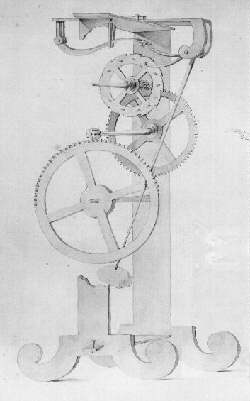Lecture 1: The Method(s) of Science I : Introduction
| Previous | Next | Syllabus | Selected References | Home |
| 0 | 1 | 2 | 3 | 4 | 5 | 6 | 7 | 8 | 9 | 10 | 11 | 12 | 13 | 14 | 15 | 16 | 17 | 18 | 19 | 20 | 21 | 22 |
Introduction
![]() Physics 7. Read
carefully, and try to identify the weak points in Wudka's definitions and in his arguments.
Physics 7. Read
carefully, and try to identify the weak points in Wudka's definitions and in his arguments.![]() On Scientific Method, a
short statement by Percy W Bridgman, a famous physicist, (Reflections of a Physicist. 2d ed. New York: Philosophical Library. 1955).
On Scientific Method, a
short statement by Percy W Bridgman, a famous physicist, (Reflections of a Physicist. 2d ed. New York: Philosophical Library. 1955).
Topics

Galileo's Design for a Pendulum Clock
- Make some observations
- Formulate a hypothesis that seems to be consistent with your observations
- Make new observations, and check whether your hypothesis is also consistent with them
- If necessary, modify your hypothesis to fit both old and new observations
- Repeat the procedure, until there are no more discrepancies between your hypothesis and all your observations
- If this is not possible, discard your hypothesis and try to replace it with a better one. And so on...
- In 1772 a German astronomer, Johann Ehlert Bode published what became known as Bode's Law. In fact,
the credit should go to a German mathematician, Johann Titius, but that's another story... Titius and Bode, and
many other astronomers of the time, were interested in understanding why the planets are where they are in
the solar system. Why should the Earth orbit at about 150,000,000 km from the Sun? This is a
difficult question, and even today we don't really have a satisfactory answer. By the late
eighteenth century astronomers had already measured the distances of all the planets then known from
the Sun. These were the initial observations Bode started with. When you look at
the data, keep in mind that the farthest
planet known at the time was Saturn. Bode tried to find a hypothesis that would fit these
data. He came up with a simple formula. He first expressed all the data in so-called
astronomical units. One AU is the average distance of the Earth from the Sun. His hypothesis
was as follows:
- Assign the number 0 to Mercury, 3 to Venus, 6 to Earth, 12 to Mars, 24 to Jupiter and 48 to Saturn
- Add 4 to each of these numbers
- Divide the results by 10
If you now compare the numbers so obtained to the actual distances of these planets from the Sun, you find a remarkable match. Of course you may well ask: why 0, 3, 6. etc.? why add 4? why divide by 10? The answer is that initially a hypothesis must only satisfy one criterion: it must fit the data. You may get the idea from a dream, from a genie, from the depths of your unconscious, from wherever. Is it consistent with the observations? If yes, you are in business. Bode was in business. Well,...almost. You see, the Asteroid Belt, an area between Mars and Jupiter where we now know thousands of smaller bodies orbit, had not been discovered yet. So, the predicted distance for Jupiter was too small, and so was that of Saturn (which in fact seemed to correspond to the actual distance of Jupiter). Since however things were fine for Mercury, Venus, Earth and Mars, Bode was reluctant to abandon his hypothesis. Please note: if Bode had been following the scientific method as outlined above, he should have discarded his hypothesis. But he did not, perhaps because he hoped there was more to the solar system than he knew.
- In 1781 a British astronomer, William Herschel, discovered Uranus. Bode extended his table, by assigning 96 to Uranus and applying the formula. Unfortunately the formula predicted the wrong distance for Uranus (but strangely, once again, the number so obtained seemed to correspond to another planet, Saturn).
- Then, on January 1st, 1801, an Italian astronomer, Giuseppe Piazzi, discovered a small planet, Ceres, which was precisely at the (wrong) distance predicted for Jupiter. Now the table seemed to be correct, from Mercury to Uranus. Ceres turned out to be the biggest body in what is now known as the Asteroid Belt. Here you see the predictive power that 'good' hypotheses have.
- Bode died long before new planets were discovered. In 1846, the German astronomer Johann Galle discovered Neptune, and in 1930 the British astronomer Clyde Tombaugh discovered Pluto. Bode would have been rather disturbed by these discoveries, as you can see in the table.
- Here is one important observation: Bode's formula never stops. You can apply it over and over again, obtaining distances which do not correspond to anything. Thus, even if the known planets were to fit it perfectly, Bode's law is intrinsically flawed, as it predicts infinitely more bodies than it was asked to.
- One example is, of course, hardly sufficient to show the limitations of the scientific method. In the next lecture we will see that there are more fundamental objections to this account of how science is done.
- Leaf through some newspaper or magazine, and identify appeals to the authority of science or scientists.
- What is your current (i.e. prior to this class) understanding of what science is all about?
- When do you think science started?
- Do you think science is a phenomenon common to all cultures?
- If you have access to a good library, open the unabridged Oxford Dictionary and look up the word 'science.'
Last Modification Date: 07 July 2008